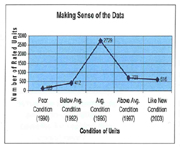
INTRODUCTION
In today’s environmentally conscientious society, Limited Brands Inc. is doing its part to reduce emissions, and create a cleaner, safer atmosphere. With a portfolio of nearly 3,000, mostly mall-based stores, Limited Brands owns and maintains over 4,500 HVAC rooftop units (RTU) that cool and heat over half its fleet of stores. The remaining stores have mall-supplied heating and cooling systems.In 2006, Limited Brands instituted a proactive HVAC replacement program that will bring the average age of its equipment to 7 years. Currently, the average age of the entire HVAC portfolio is 10 years. The idea is to have and maintain more energy-efficient units that will: 1) be better for the environment, 2) reduce store downtime from emergency replacements, 3) maintain a more comfortable shopping environment for the customers, 4) keep the RTU technologically current with more efficient units, and 5) keep up with the federal mandate for more environmentally friendly refrigerants.
Managing and maintaining the fleet of HVAC units requires a process-driven system that draws unit related data from our equipment suppliers, as well as equipment condition data from our vendor-based HVAC contractors and technicians. The data is analyzed and used to assist the engineers and maintenance coordinators with prioritizing the units for replacement. Limited Brands uses the robust FMPilot maintenance database to capture store data, and report efficiencies, cost, and performance. The system keeps track of information like the number of preventive maintenance (PM) screenings performed on each unit, average age and condition of the HVAC units, and gives us a solid database for analyzing the equipment and for financial reporting.
Going “green” can sometimes be an expensive venture, however, this proactive HVAC replacement program that I have instituted at Limited Brands is all about doing the right thing economically and effectively. Should others try to do a project like this, this article will give a synopsis of how to get started (i.e., gathering the data), what to look for (i.e., analyzing and making sense of the data), determining the project cost, getting buy-in from upper management, and implementing the project with minimal or no interruption to the store operations.

Figure 1. (Click on the chart for an enlarged view.)
ANALYZING THE DATA
There are six basic pieces of information that Limited considers when analyzing the HVAC equipment data, and these are used to determine the sequence of units to be replaced in a proactive replacement program. Although there are other methods that can be used to predict when a unit will fail, Limited has not found them to be cost effective. My approach was to use the information I had without adding too much more than equipment and labor cost to the project.The information listed below is an accurate representation of equipment specifications, maintenance, and cost data, as they are necessary for the analysis stage of the proactive replacement program:
1.Rated condition
2.Age of unit
3.Repair time and materials (T&M) cost data
4.Cost of replacing the unit in emergency situations
5.Efficiency of unit
6.Energy cost for operating the unit

Figure 2. (Click on the chart for an enlarged view.)
The information is accessed in report format from FMPilot and is analyzed semi-annually. This is why accurate data is crucial to have when deciding which units are to be replaced first.
Other critical evaluation information includes real estate strategies (i.e., store remodel, relocation, or closing), local cost of electricity, energy usage, and the cost to operate vs. age comparison. Limited Brands monitors energy usage in over 10 percent of its stores with utility grade electric meters that are installed in each store. This breakdown of electric loads, which include HVAC/lighting/other, is shown in Figure 2. In the case of cost vs. age, be aware that although a unit may be older and may be operating at low efficiency, it may have very low maintenance cost. You can determine where on the replacement list this unit is prioritized.

Figure 3. (Click on the chart for an enlarged view.)
DECIDING WHAT TO REPLACE
After reviewing the analysis, the most obvious direction is to replace all units that are in poor condition first, then continue with the below average units, etc. See Figure 3 for the chart that displays the rated condition of the entire portfolio of HVAC units. This really exaggerates the hypothesis that the majority of the units would be in average condition. One hundred and twenty five (125) units were rated to be in poor condition, which represented only 3 percent of the entire fleet.In fall of 2006, my team and I selected 40 of these 125 units, which represented the “worst of the worst.” Replacing these units gave us an opportunity to test and tweak the replacement process, as well as to achieve the greatest savings opportunities first.
For the Limited Brands proactive HVAC replacement program the decision was also made to replace like-for-like equipment, as other alternatives would not have been as cost effective. Some new units required curb adaptors, additional installation permits, and approvals due to the weight of the units. In some cases, the malls were not in favor of adding new curb adapters, and they definitely did not want additional load on the roof.
Opting to go with like-for-like equipment replacement simplified the process immensely. We already knew whom the equipment supplier was, and the replacement quotes were requested from our reliable vendor-base in FMPilot. The process for getting equipment and installation quotes from our established providers was seamless.
Once all bids were in, the cost data analysis became the focal point of the project. We coordinated and analyzed all cost data to create an attractive and convincing financial justification to upper management for the replacement project. We had to show that the alternative, which would mean being reactive to unit failure, would be more costly than being proactive.

Figure 4. Example of financial analysis.
GETTING FINANCIAL APPROVAL
Preparing a financial business plan to proactively replace 40, 400, or even 4,000 HVAC units is not an easy task because the return on investment has to be sound and the program has to meet certain financial criteria.Sometimes the decision to replace aging HVAC units (which are still operating) has to be based on doing the right thing rather than on just a typical rate of return. In this case, the business plan is to protect the store environment by replacing the units versus waiting for the units to fail.
At Limited Brands, “the customer rules” and any disruption that interferes with the customer’s shopping experience requires immediate attention. So, our justification for being proactive rather than reactive included alleviating things like:
1.Negative impact to the customer’s shopping experience;
2.Loss of sales because the store is too hot; or
3.Having unsightly temporary cooling equipment inside the stores.
The aforementioned list is a legitimate platform to start your plea for proactive HVAC replacement dollars. No one wants to shop in a hot store, or in a store that is too cold.
The key questions are:
1.How will this investment benefit the company financially?
2.What are the quantifiable and non-quantifiable benefits for making this investment?
Sometimes the non-quantifiable outweighs the quantifiable because it is the cost of doing business and is definitely the right thing to do operationally, and for the environment.
Other items to be incorporated into the financial model are: 1) the higher cost for emergency replacements, and 2) the high cost of leasing temporary cooling equipment and fans to cool the store while waiting for the new unit to be installed, because they are a significant part of the financial case.
Electricity cost is one of the largest expenses in retail operations, and anything to reduce that cost should be included in your financial model. In saying so, states with high cost of electricity should be one of the considerations for the proactive replacement project. Show data that will convince upper management why leased equipment could be more costly than the new unit depending on how long it takes for the unit to be ordered, shipped, and installed. Do make note that sometimes there is a need to get city permits, and if a crane is required for the installation you will need special mall permits. Unless the unit is a stocked item, the installation process of the new unit could take up to 45 days. These costs, when combined with high energy costs, less efficient units, loss of sales, and maintenance costs, show very favorable return on investment and have a big impact on financial payback.
Even with all the above considerations, the financial justification may not show a favorable return on investment, and this is where doing the right thing and the cost of doing business should stand on their own merit.
See Figure 4 for an example of what goes into the start of a good financial evaluation. First, you start out with the total number of units in your fleet, and how much it costs per year to operate them. Break them down by division if necessary. Take the entire operating HVAC capital and compare that to the number of stores with HVAC units that actually used that money for requested maintenance or parts replacements for that year. In the case of Limited Brands they were costing 4 percent more in maintenance expense. Now, take a look at your energy bills and see how much more money the units in poor condition are costing. Just as an FYI, a proactive HVAC replacement program may not be justified based on energy savings alone.
In this case, we saw about 200 units that were really using a lot of maintenance dollars and so we chose those units to continue the replacement process. The first 40 units were to be done in 2006, and the remaining 160 to be replaced in 2007. Bear in mind that your company’s real estate strategies may decrease the number of units to be replaced, but you can always continue your selections with the “below average” units, etc., and do the same comparisons that are noted above as you continue your proactive replacement program. Each year, units continue to age and those in “below average” condition become the “poor” condition candidates for replacement.
Based on the above financial table (Figure 4), the amount of money you would be requesting to replace 200 units would be $3.2 million, maintenance savings would be $73,000, plus an additional $51,000 in energy savings per year. This alone cannot make your case; you will have to get other information like loss of sales due to equipment failure and cost of temporary cooling equipment for a more favorable return on investment.
CONCLUSION
In conclusion, we can deduct that there are no “cookie cutter” solutions as to whether or not you proactively replace your HVAC equipment. Each company should do whatever model fits their operation.In the case of Limited Brands, we chose a proactive approach to HVAC unit replacement because it benefits stores and our customers, while maintaining one of our core values, to do the right thing.
Publication date:09/10/2007

Report Abusive Comment